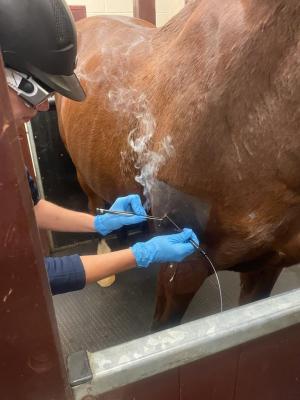The Power of Equine Therapy for Stress And Anxiety, PTSD, and Psychological Healing
The Power of Equine Therapy for Stress And Anxiety, PTSD, and Psychological Healing
Blog Article
How Laser Treatment in Horse Treatment Is Changing Veterinary Look After Horses
Laser treatment has emerged as a transformative approach in equine veterinary care, supplying a non-invasive option that accelerates healing and enhances general wellness. The transportability and adaptability of laser therapy gadgets further underscore their growing necessity amongst veterinarians.

Comprehending Laser Therapy
Comprehending laser therapy is important for appreciating its role in equine treatment. Laser therapy, likewise referred to as photobiomodulation, entails the application of particular wavelengths of light to tissues, which can cause various organic impacts. This restorative method utilizes the power of light power to penetrate the skin and underlying tissues, boosting cellular processes and improving cells repair work.
The technology behind laser treatment is based in the principle of photochemistry, where photons are taken in by chromophores within cells, causing enhanced ATP manufacturing and inflection of reactive oxygen species. This, subsequently, promotes cellular expansion, decreases inflammation, and accelerates healing. Veterinary professionals utilize various kinds of lasers, consisting of low-level lasers (LLLT) and high-power Class IV lasers, depending on the specific therapeutic goals and the nature of the equine problem being dealt with.
Various laser wavelengths and power settings are carefully selected to target numerous cells midsts and achieve desired scientific results. Safety and security methods are paramount, as improper usage can bring about thermal damages or suboptimal healing results. Hence, a detailed understanding of laser treatment's devices and applications is important for its efficient implementation in equine vet practice.
Benefits for Horse Health
The myriad benefits of laser treatment for equine health and wellness encompass enhanced recovery, discomfort decrease, and enhanced mobility. This advanced therapy modality leverages certain wavelengths of light to penetrate tissues, stimulating cellular function and promoting fast tissue repair work. The non-invasive nature of laser therapy ensures very little anxiety and discomfort for the steed, promoting a smoother healing process.

By decreasing swelling and discomfort, and improving cells repair work, laser treatment aids in recovering joint function and muscle flexibility. Therefore, laser treatment stands as a transformative device in contemporary horse vet care.
Usual Conditions Treated
Laser therapy has arised as a functional therapy alternative for a selection of typical equine conditions. Additionally, laser treatment is efficient for problems like osteoarthritis, where it assists mitigate joint swelling and promote tissue repair work.
Wound administration is one more location where laser therapy has actually revealed significant pledge. Persistent injuries or slow-healing ulcers can be especially challenging in equines, but laser treatment enhances cellular regeneration and improves blood circulation, hence expediting the healing procedure. Laser treatments have been efficiently used in handling unguis conditions such as laminitis and abscesses, reducing discomfort and promoting quicker healing.
Equine professional athletes typically deal with performance-related problems like muscle mass pain and anxiety fractures. Laser treatment help in minimizing muscle fatigue and quickens the recovery of micro-injuries, therefore ensuring that equines return to peak efficiency quicker. By attending to these varied problems, laser treatment is changing the landscape of veterinary care, providing a non-invasive, efficient option to conventional therapies.
Innovation Behind Laser Therapy

Laser tools utilized in veterinary medicine frequently utilize low-level laser therapy (LLLT) or cold laser therapy. Unlike high-powered surgical lasers, these tools run at lower power levels, enhancing therapeutic benefits while decreasing thermal damage. The energy from the laser light stimulates adenosine triphosphate (ATP) production, enhances cellular metabolism, and increases tissue repair service processes.
Modern laser therapy tools for equine therapy is designed with adjustable setups to deal with the specific needs of different tissues and conditions. Equine Therapy. Parameters such as wavelength, power thickness, and treatment duration can be carefully tuned, providing customized restorative remedies. In addition, advancements in laser modern technology have caused the advancement of mobile, handheld devices, making it simpler for veterinarians to supply treatment in a variety of settings, from facilities to stables. This technological technology is a cornerstone in the changing of equine veterinary treatment.
Success Stories and Case Research Studies
Showcasing the tangible benefits of laser therapy, countless success stories here and situation research studies brighten its transformative impact on equine health. One such instance involves a purebred racehorse struggling with persistent tendonitis. Standard treatments produced minimal renovation, however after integrating laser treatment into the regimen, the equine displayed substantial reductions in swelling and pain within weeks, ultimately going back to competitive auto racing.
An additional engaging instance includes a dressage steed detected with serious neck and back pain, limiting its performance. A veterinary group used low-level laser therapy (LLLT) to target the inflamed locations, leading to significant renovation in versatility and a noteworthy decrease in discomfort. Over several sessions, the horse regained its peak form, showcasing the efficiency of laser treatment in resolving bone and joint issues.
In addition, a research conducted at a leading equine facility taken a look at 50 steeds with different soft cells injuries treated with laser treatment. The outcomes were striking: 85% of the horses demonstrated sped up recovery times and improved flexibility. These instances highlight the adaptability and performance of laser treatment in equine medicine, offering a non-invasive, scientifically-backed technique to boosting recovery and efficiency in equines.
Conclusion
Laser therapy is changing equine veterinary treatment by offering a non-invasive treatment that accelerates recovery, decreases inflammation, and alleviates pain. With its effectiveness in treating a variety of conditions, from bone and joint injuries to persistent conditions like osteoarthritis, this innovation significantly boosts equine wellness and mobility. The portability and adaptability of laser treatment additionally emphasize its transformative impact on veterinary practices, strengthening its duty as a vital tool in modern equine medical use this link care.
Report this page